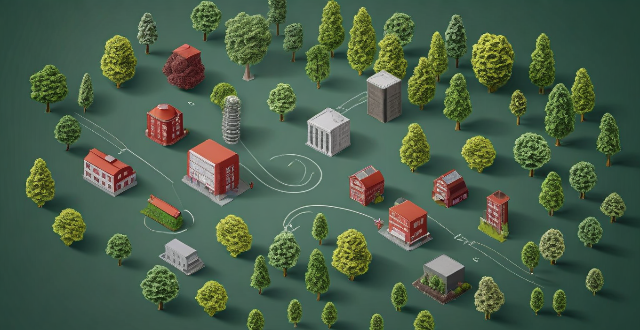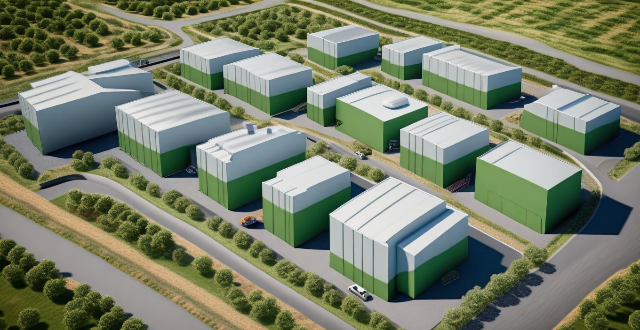Technology Carbon

What are the ethical considerations surrounding the use of carbon capture technology ?
Carbon capture technology is a method used to reduce carbon dioxide emissions, but it raises ethical concerns such as cost and accessibility, potential environmental impact, long-term effects, and accountability. It is important to ensure that the technology is implemented responsibly and equitably.

Is carbon capture technology a viable solution for industries with high carbon emissions ?
Carbon capture technology (CCT) is a process that captures carbon dioxide (CO2) emissions from burning fossil fuels and stores it to prevent its release into the atmosphere. This technology has been proposed as a solution to reduce greenhouse gas emissions from industries with high carbon footprints. However, there are both advantages and challenges associated with CCT. The primary advantage of CCT is its potential to significantly reduce greenhouse gas emissions from power plants and other industrial processes by capturing up to 90% of CO2 emissions. It also allows the continued use of fossil fuels while reducing their environmental impact, which is particularly important for countries heavily reliant on coal or natural gas for their energy needs. Additionally, the development and implementation of CCT could create new job opportunities in research, engineering, construction, and operation of these facilities. However, one of the biggest challenges facing CCT is its high cost. The installation and operation of carbon capture systems can be expensive, making it difficult for many companies to invest in this technology. Carbon capture processes also require energy, often from burning more fossil fuels, which can lead to a net increase in CO2 emissions unless the energy source is renewable. Once captured, CO2 needs to be transported and stored safely, requiring infrastructure that does not currently exist in many regions and raising concerns about leakage and long-term storage solutions. In conclusion, while carbon capture technology offers promising benefits for reducing greenhouse gas emissions from industries with high carbon footprints, it also presents significant challenges that need to be addressed before it becomes a widely adopted solution. Cost-effectiveness, energy requirements, and storage infrastructure are key areas that require further development and investment to make CCT a viable option for combating climate change.

How can we improve carbon capture technology to make it more efficient and cost-effective ?
Carbon capture technology is a crucial tool in the fight against climate change. However, the current state of this technology is not yet efficient or cost-effective enough to be widely adopted. To improve carbon capture technology, we need to enhance efficiency and reduce costs through advancements in material science, optimization of processes, integration with other technologies, direct air capture, economies of scale, government incentives, private investment, improved maintenance and operation, and continuous research and development. With these efforts, we can make carbon capture technology accessible and practical for widespread use in the fight against climate change.

What are the potential benefits of carbon capture technology for the environment ?
Carbon capture technology can help reduce greenhouse gas emissions, improve air quality, encourage economic growth, and enhance ecosystem health. It has the potential to mitigate climate change, meet emission reduction targets, enhance energy security, reduce pollutants, protect human health, create jobs, stimulate innovation, promote clean energy, protect biodiversity, preserve natural resources, and restore degraded landscapes. Investing in carbon capture technology may prove to be crucial for creating a more sustainable future.

How can green technology reduce carbon emissions ?
In this article, we explore how green technology can help in reducing carbon emissions. We discuss renewable energy sources such as solar, wind, hydro, geothermal, and biomass energy, which produce little to no greenhouse gas emissions during operation. We also emphasize the importance of improving energy efficiency and conservation, utilizing carbon capture and storage technologies, and promoting electric vehicles. By implementing these green technologies, we can significantly reduce our carbon footprint and create a more sustainable future for generations to come.

What is carbon capture technology and how does it work ?
Carbon capture technology is a set of methods aimed at reducing CO2 emissions from power plants, industrial processes, and other sources. The main types are post-combustion capture, oxy-fuel combustion, and pre-combustion capture, each with its specific techniques and challenges. While these technologies offer significant potential in the fight against climate change, they face economic and logistical barriers such as high costs and the need for safe storage solutions. Ongoing research seeks to improve efficiency and reduce costs, making carbon capture an increasingly viable solution in achieving net-zero emissions targets.

Can carbon capture technology be used in conjunction with other renewable energy sources ?
Carbon capture technology can be used with renewable energy sources to reduce greenhouse gas emissions and mitigate climate change. There are several ways that this technology can be used, including post-combustion capture, pre-combustion capture, oxy-fuel combustion, and chemical looping combustion. However, there are also challenges and considerations that must be taken into account, such as cost, energy requirements, and storage.

How effective is a carbon tax in reducing greenhouse gas emissions ?
A carbon tax is a fee on burning carbon-based fuels aimed at reducing greenhouse gas emissions. It creates economic incentives for behavior change, technology innovation, and revenue generation. The effectiveness depends on rate setting, equity concerns, compliance, political feasibility, and international coordination.

What are the benefits of carbon capture technology ?
Carbon capture technology offers benefits such as reduced greenhouse gas emissions, improved energy efficiency, economic opportunities, and potential for climate change mitigation.

How does a carbon tax compare to other methods of reducing carbon emissions ?
The article discusses the comparison of a carbon tax to other methods of reducing carbon emissions. It explains what a carbon tax is and lists other methods such as renewable energy sources, energy efficiency, carbon capture and storage, and forest management. The article then compares these methods in terms of cost-effectiveness, implementation speed, public acceptance, and environmental impact. It concludes that while a carbon tax is effective, it should be part of a broader strategy including investments in renewable energy, energy efficiency measures, CCS technology, and forest management for the best results in combating climate change.

How can a carbon tax be designed to minimize negative impacts on businesses ?
A carbon tax is a fee on burning carbon-based fuels to reduce emissions and promote clean energy. To minimize its negative impact on businesses, consider gradual implementation, incentives for innovation, clear policy, revenue neutrality, support for affected industries, collaboration, and monitoring. This balances environmental goals with economic realities for sustainable development.

What are the economic implications of pursuing carbon neutrality for a country ?
Pursuing carbon neutrality has both positive and negative economic implications for a country, including job creation, innovation, energy independence, short-term costs, impacts on traditional industries, and potential carbon leakage.

Is it realistic for all industries to aim for carbon neutrality ?
The text discusses the feasibility and challenges of achieving carbon neutrality across all industries. It highlights industry-specific challenges, economic implications, and technological limitations as significant hurdles. However, it also points out opportunities such as innovation, market advantage, and regulatory compliance that can arise from pursuing carbon neutrality. The strategies for achieving carbon neutrality include improving energy efficiency, switching to renewable energy sources, using carbon capture and storage technology, and offsetting emissions through various projects. While the path to carbon neutrality varies by industry, collaboration between different stakeholders is crucial for creating a sustainable future.

What technologies are being developed to help reduce carbon footprint ?
The text discusses various technologies being developed to help reduce carbon footprint, including renewable energy sources such as solar, wind, hydro, and geothermal power; electric vehicles (EVs) with improving battery technology and charging infrastructure; energy efficiency through building design, appliance efficiency, and smart grids; carbon capture and storage (CCS); and nuclear power. These technologies aim to combat climate change by reducing greenhouse gas emissions and promoting sustainable practices.

How much does it cost to implement carbon capture technology ?
The article discusses the cost of implementing carbon capture technology, which is a critical tool in combating climate change. The cost can be influenced by various factors such as the type of technology, scale of implementation, location, economic conditions, and regulatory requirements. According to estimates from the International Energy Agency, the cost of capturing CO2 from coal-fired power plants ranges from $50 to $100 per tonne, while for natural gas-fired power plants, it ranges from $70 to $110 per tonne. These costs do not include transportation and storage expenses. As technology advances and more facilities adopt carbon capture solutions, the cost is expected to decrease over time. Despite the initial high investment, the long-term benefits of reducing CO2 emissions make carbon capture technology a worthwhile endeavor.

What are the latest trends in basketball shoe design and technology ?
The latest trends in basketball shoe design and technology include the use of lightweight materials, energy return systems, customization options, sustainability initiatives, and smart technology integration. These advancements aim to enhance performance, style, and environmental consciousness while providing players with personalized footwear choices.

What is carbon capture and how does it work ?
Carbon capture, a technology to reduce CO2 emissions from industrial processes and power generation facilities, comprises three main types: post-combustion, oxy-fuel combustion, and pre-combustion. Each method captures CO2 differently, and the captured gas can be stored or used for other purposes. Carbon capture offers benefits such as reducing greenhouse gas emissions and supporting the transition to a low-carbon economy but faces challenges like high costs and energy requirements.

What are the benefits of implementing a carbon credit system ?
The carbon credit system is a market-based approach to reducing greenhouse gas emissions. It provides economic incentives for emission reduction, promotes innovation and technology adoption, enhances environmental stewardship, and serves as a regulatory and policy tool. By creating a market value for emission reduction, the system encourages businesses to reduce their carbon footprint and fosters global cooperation towards sustainability goals.

How can Smart Grid Technology reduce carbon emissions ?
Smart grid technology can reduce carbon emissions by improving energy efficiency, integrating renewable sources, enhancing system reliability, engaging consumers, and optimizing transmission and distribution.

How do carbon credit systems impact developing countries ?
Carbon credit systems can have both positive and negative impacts on developing countries, including economic development, environmental benefits, technology transfer, market risks, social impacts, and environmental concerns. Policymakers and stakeholders must carefully consider these impacts when designing and implementing carbon credit projects in developing countries.

What is carbon sequestration and how does it work ?
Carbon sequestration is a process that aims to reduce the concentration of carbon dioxide (CO2) in the atmosphere by capturing and storing it. This can be achieved through various methods, including afforestation, soil carbon sequestration, bioenergy with carbon capture and storage (BECCS), direct air capture (DAC), ocean carbon sequestration, and enhanced weathering. The benefits of carbon sequestration include mitigating climate change, improving soil health, restoring ecosystems, and creating economic opportunities. However, large-scale implementation of carbon sequestration projects faces challenges, and continued research and investment are necessary to achieve global climate goals.

What are the challenges associated with implementing carbon capture on a large scale ?
Carbon capture and storage (CCS) is a technology that aims to reduce greenhouse gas emissions by capturing carbon dioxide (CO2) from industrial processes and storing it underground. Implementing CCS on a large scale poses several challenges, including high costs, technology maturity, storage capacity, regulatory and legal barriers, public perception, and energy requirements. Overcoming these challenges is essential for the successful implementation of CCS on a large scale. Collaboration among governments, industry, and researchers will be necessary to develop more efficient and cost-effective carbon capture technologies, establish clear regulations and liability frameworks, and raise public awareness about the benefits of CCS.

How does climate-smart technology help in reducing carbon emissions ?
Climate-smart technology plays a crucial role in the global effort to reduce carbon emissions and mitigate the effects of climate change. These technologies are designed to improve energy efficiency, promote renewable energy sources, and optimize industrial processes to minimize their environmental impact. Here's how they contribute to reducing carbon emissions: 1. Energy Efficiency Improvements: Building Automation Systems (Smart Thermostats & Lighting Controls), Transportation Efficiency (Electric Vehicles, Hybrid and Plug-In Hybrid Vehicles). 2. Renewable Energy Sources: Solar Power (Photovoltaic Cells & Solar Water Heaters), Wind Energy (Turbines), Geothermal Energy (Heat Pumps). 3. Industrial Process Optimization: Carbon Capture and Storage (Post-Combustion Capture & Oxy-Fuel Combustion), Process Efficiency (Lean Manufacturing & Industrial Symbiosis). 4. Waste Management and Recycling: Anaerobic Digestion (Organic Waste Treatment), Recycling Technologies (Material Recovery Facilities). 5. Agriculture and Land Use: Precision Farming (GPS-Guided Equipment & No-Till Farming), Forestry Management (Afforestation & Reforestation, Sustainable Forestry Practices). 6. Conclusion: Climate-smart technology offers a diverse array of solutions that, when implemented collectively, can significantly reduce carbon emissions across various sectors of society. By embracing these advancements, we can create a more sustainable future and help combat the escalating challenges of climate change.

How effective are current climate and environmental policies in reducing carbon emissions ?
The effectiveness of current climate and environmental policies in reducing carbon emissions varies, with global initiatives like the Kyoto Protocol and Paris Agreement showing mixed results. National policies such as renewable energy targets, carbon pricing mechanisms, and energy efficiency standards have contributed to emission reductions but face political and economic challenges. Technological advances have lowered the cost of clean energy solutions. However, significant reductions require stronger governmental commitment, financial investments in green technology, and increased public engagement.

What are the main challenges faced by carbon capture technology ?
Carbon capture technology faces challenges in scalability, integration, high costs, lack of incentives, storage solutions, and ecological impact. Addressing these issues is crucial for its successful deployment at a global scale.

In what ways can technology accelerate energy transition ?
Energy transition is the process of shifting from traditional, non-renewable energy sources to cleaner and more sustainable alternatives. Technology plays a pivotal role in this transition by improving efficiency, reducing costs, and enhancing the performance of renewable energy systems. Key areas where technology can make a difference include renewable energy production, energy storage, smart grids, energy efficiency, and carbon capture and utilization. Innovations in these areas promise a cleaner, more sustainable, and resilient energy future for all.

Can developed and developing countries achieve carbon neutrality at the same pace ?
The article discusses the challenges and potential solutions for developing countries to achieve carbon neutrality at the same pace as developed countries. The key differences between developed and developing countries in terms of economic development, technological advancements, and political will are highlighted. Developed countries have higher GDP per capita, more resources for research and development, and greater financial capacity to invest in renewable energy infrastructure. In contrast, developing countries have lower GDP per capita, limited resources for research and development, and less financial capacity to invest in renewable energy infrastructure. Technological advancements also play a crucial role in achieving carbon neutrality. Developed countries have advanced technology and innovation in clean energy sectors, access to cutting-edge research facilities, and well-established industries with experience in implementing sustainable practices. In contrast, developing countries have emerging technology and innovation in clean energy sectors, limited access to advanced research facilities, and infant industries with less experience in implementing sustainable practices. Political will is another factor that affects the pace of achieving carbon neutrality. Developed countries have stronger political commitment to addressing climate change through policy measures, more established regulatory frameworks for promoting renewable energy adoption, and greater public awareness and support for environmental issues. In contrast, developing countries have varying levels of political commitment to addressing climate change through policy measures, less established regulatory frameworks for promoting renewable energy adoption, and lower public awareness and support for environmental issues due to other pressing concerns such as poverty and healthcare. Developing countries face several challenges in achieving carbon neutrality, including lack of financial resources, technological barriers, and infrastructure challenges. Potential solutions for developing countries include international cooperation and funding, capacity building and education, and policy interventions and regulatory reforms. By working together through these solutions, both developed and developing countries can make significant progress towards a more sustainable future.

What is the future of carbon credit systems ?
The future of carbon credit systems is uncertain and depends on various factors such as policy decisions, technological advancements, public opinion, and market dynamics. Governments play a crucial role in shaping the future of these systems through regulations and enforcement. Technological innovations can both increase and decrease the value of carbon credits. Public opinion can drive demand for carbon credits, while market dynamics will shape the industry's evolution. Despite challenges, there are opportunities for growth and improvement in this important area of environmental protection.

How do energy-efficient appliances help decrease carbon footprints ?
Energy-efficient appliances contribute to a smaller carbon footprint by reducing energy consumption, improving efficiency, and having a longer lifespan. Government incentives encourage the adoption of these eco-friendly options, leading to lower energy bills, increased comfort, environmental sustainability, reduced maintenance costs, and enhanced property value. Examples of energy-efficient appliances include refrigerators, washing machines, air conditioners, light bulbs, and water heaters. By choosing energy-efficient appliances, we can all contribute to a greener planet and a healthier future for generations to come.

How can carbon capture technology be scaled up to address global climate change ?
The article discusses the challenges and strategies associated with scaling up carbon capture technology (CCT) to mitigate global climate change. The challenges include high costs, technological limitations, infrastructure and logistics issues, and regulatory and legal frameworks. To overcome these challenges, strategies such as policy and economic incentives, technological innovation, infrastructure development, public-private partnerships, and international cooperation are proposed. Scaling up CCT is crucial in reducing atmospheric CO2 levels and combating global climate change.